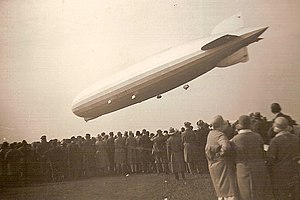
Back أل زد 127 غراف زبلن Arabic Graf Zeppelin LZ 127 AST LZ 127 Graf Zeppelin Catalan LZ 127 Graf Zeppelin Czech LZ 127 Graf Zeppelin Danish LZ 127 German LZ 127 Graf Zeppelin Spanish LZ 127 Graf Zeppelin Estonian LZ 127 Graf Zeppelin Basque Graf Zeppelin Finnish
| LZ 127 Graf Zeppelin | |
|---|---|

| |
| Role | Commercial passenger airship |
| National origin | Germany |
| Manufacturer | Luftschiffbau Zeppelin |
| Designer | Ludwig Dürr |
| First flight | 18 September 1928 |
| Introduction | 11 October 1928 |
| Retired | 18 June 1937 |
| Status | Scrapped March 1940 |
| Career | |
| Construction number | LZ 127 |
| Registration | D-LZ 127 |
| Radio code | DENNE[1] |
| Owners and operators | Deutsche Luftschiffahrts-Aktiengesellschaft; from 1935, Deutsche Zeppelin Reederei |
| Flights | 590 |
| Total hours | 17,177 |
| Total distance | 1.7 million km (1.06 million miles) |
LZ 127 Graf Zeppelin (Deutsches Luftschiff Zeppelin 127) was a German passenger-carrying hydrogen-filled rigid airship that flew from 1928 to 1937. It offered the first commercial transatlantic passenger flight service. The ship was named after the German airship pioneer Ferdinand von Zeppelin, a count (Graf) in the German nobility. It was conceived and operated by Hugo Eckener, the chairman of Luftschiffbau Zeppelin.
Graf Zeppelin made 590 flights totalling almost 1.7 million kilometres (over 1 million miles). It was operated by a crew of 36, and could carry 24 passengers. It was the longest and largest airship in the world when it was built. It made the first circumnavigation of the world by airship, and the first nonstop crossing of the Pacific Ocean by air; its range was enhanced by its use of Blau gas as a fuel. It was built using funds raised by public subscription and from the German government, and its operating costs were offset by the sale of special postage stamps to collectors, the support of the newspaper magnate William Randolph Hearst, and cargo and passenger receipts.
After several long flights between 1928 and 1932, including one to the Arctic, Graf Zeppelin provided a commercial passenger and mail service between Germany and Brazil for five years. When the Nazi Party came to power, the Graf Zeppelin was used as a propaganda tool. The airship was withdrawn from service after the Hindenburg disaster in 1937, and scrapped for military aircraft production in April, 1940.
- ^ Lehmann (1937), p. 24.
© MMXXIII Rich X Search. We shall prevail. All rights reserved. Rich X Search